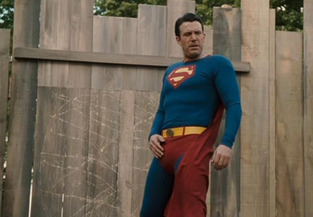Why the world doesn’t need a Superman…
At the end of both versions of Superman II, Clark returns to the diner where a bully had beaten him up during him brief stint as a human. With his powers fully restored, Clark issues a little payback. It might seem out-of-place for the Boyscout to exact some revenge, but I believe it was a crucial. It showed Superman, despite the humble, idealistic crusader for “truth, justice, and the American way” was still…just a man.
Superman Returns is world-class film-making hand-delivered by Bryan Singer, who revered Richard Donner’s initial Superman films so much that he had to opted to pay homage in every crevace he could find. Already starting the comic-book film craze of the 21st century (that grows to this day), Singer bypassed a third outing in X-Men to restore Superman to the same heights attained in 2002’s Spiderman and the previous year’s Batman Begins. But Singer never gives his new Superman (Brandon Routh) a bully scene. Instead, Routh — looking the part — is too noble. You get the sense that Routh’s Superman would ask you not to talk during the movie, even if the theater was empty.
Returns is a direct sequel to the first two original films; seemingly ignoring any traces of Pryor or Nuclear Man. Although Returns makes for a much better third chapter, Singer borrows so many elements from Donner’s version that it feels like we’re treading the same waters. He aims for the same awe and loving resonance. The film merely tickles our emotions. We’re never left with the same giddy excitement and romantic intrigue.
The film opens with a long paragraph — which feels more like Cliff Notes than “Star Wars” — informing us that Superman took a five-year journey back to Krypton, leaving the Earth to fend for themselves. Singer tries to instill Superman’s real-life long-term cinematic absence within the confines of his sequel. However, this plot element lacks any payoff. Why on Earth would Superman abandon his mother and girlfriend to return to a planet that was fully destroyed. As we would guess, Superman’s journey was in vain.

Singer attempts to continue Donner’s themes: Superman’s alien origins, his lonely path, his inability to live the life of a normal human. Singer uses John Ottoman’s music to convey a sense of melancholy. There’s a nice scene when a morose Superman flies into the heavens, having just learned that Lois has denounced him. (Yes, he spies on Lois using his super-hearing and x-ray vision. Yes, it is creepy.) During Superman’s absence, Lois not only got married, but she has a son. Superman retreats to space and lamented stands guard, honing his super hearing over the world for signs of trouble. By no coincidence, he hovers in a Christ-like pose.
Singer’s Superman Returns succeeds by instilling a sense of fun and awe that’s been missing since Superman II. The Metropolis civilians have a naive sense of innocence — the kind that Donner imbued. Unlike Gotham City, his Metropolis is bright and futuristic. The detriment is that Superman’s absence doesn’t seem to have hindered the world. Of course, we catch brief glimpses of the news. Superman/Clark witnesses violence, destruction, and chaos, but the idea that the world has turned upside down since Superman’s departure is lost. Why does the world need a Superman?

As much as Singer aims for our heartstrings, his failures have much to do with the casting. Instead of allowing Brandon Routh to ingrain Superman with his own ingredients, Routh seems to constricted to mimicking the character brought to life by Christopher Reeve. Unfortunately, Routh lacks the same chops to present Clark as a complete square. Also, his Clark doesn’t possess the same character deviations from his alter-ego, making his mild disguise borderline asinine.
Routh’s Superman is noble to a fault. Routh unsure as to how to play Superman outside the confines of the stoic, goody-two-shoes. Reeve always seemed confident playing the Boyscout with the slightest edge to him humanity and dimension. But Routh always speaks to Lois in plain-spoken English with never the slightest inflection. Singer fails to give Routh liberty to reveal fallibility which makes for one uninspired Superman. Routh remains Superman Returns’ biggest stumble. The kid simply looks like…a kid!
Routh fails to inject his dual roles with the same sense of duality and deviation. His Clark Kent remains a square, but Routh pulls away from the outlandish buffoonery that made Reeve’s so infectious; his disguise so credible. His goofy grin and piercing gazes are slightly creepy. However, his Superman remains an utter bore; strengthening the arguments that Superman is merely a one-dimensional character.
For the role of Lex Luthor, Singer recruited veteran, Oscar-darling, Kevin Spacey, who, surprisingly, lacks either the menace or the humor of Hackman’s performance. There are numerous sequences when Spacey seems to be sitting back waiting for something to do. Singer attempts to recycle many of Hackman’s ego-maniacal self-parody trait — Luthor even has a new trophy fling (Parker Posey) who grows fond of Luthor’s nemesis, although her rekindled conscience lacks a genuine payoff.
Kate Bosworth plays Lois, who’s bitter that Superman took a five-year-hiatus. Who could blame her? However, Bosworth is so invested in Lois’s disappointment that there is no freedom for her to embrace the quirky, humorous side delivered by Kidder. Her banter with Perry White lacks the 1940s screwball sense, but feels more like an actual debate with an actual editor.
Regardless of the acting mishaps, I enjoyed Superman Returns upon my revisit, although my level of engagement was based on outside resources. Christopher Reeve and Margot Kidder’s strong characterizations helped fill in the holes left open by their inferior successors. The use of John Williams score incurred memories and emotions during Routh’s “return” as well as his final curtain call: a final flight in outer space (although Routh denies us any affirming grin). Returns also gravitates so close to the original material. Lex’s real-estate schemes, Superman’s romantic barriers, and the usage of Kyrptonite all feel like retreads. It remains a loving tribute that sticks too close to the chest. It remains a testament to the likes of Richard Donner, Margot Kiddor, Gene Hackman, and Christopher Reeve. Superman Returns disappointed because I simply cannot accept any substitutes.
Wrap-Up
The Superman films was the first successful, big-budgeted comic book franchise. It single-handedly legitimized comic books as viable movie properties. What was considered merely childish fodder became a respected medium for family demographics. Parents could appreciate a man in tights with the same latitude as their five-year-old son.
The first two films remain one of the biggest gambles in Hollywood history. Unfortunately, the Superman films are the victims of some miscalulations and poor decisions. Just as they took off, they prematurely faltered. One has to wonder where the franchise would be had Richard Donner remained. Therefore, there will always be a sad, unfortunate kink in a saga that should have blossomed rather than wilted.
Despite Superman’s fall from grace, his lasting legacy withstands thanks to the indeniable impact that Christopher Reeve made on our culture. Like any icon, Superman was in his prime at an early age — and those will be the times we remember best: a floating icon who inspired us, who made us wonder. Even if Henry Cavill’s take fails to take off the ground, I’ll always believe a man can fly — ALWAYS.
 Before I begin, I have a confession.
Before I begin, I have a confession.























